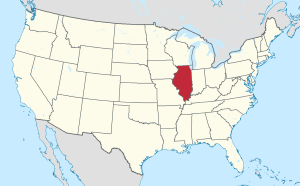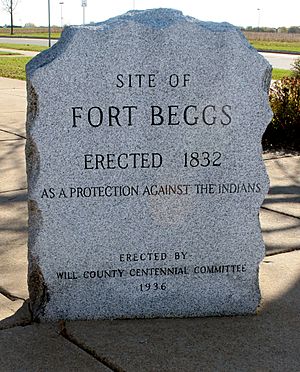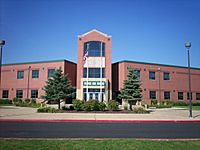Plainfield, Illinois facts for kids
Quick facts for kids
Plainfield, Illinois
|
|
|---|---|

Village Hall in Plainfield, Illinois
|
|

Location of Plainfield in Will County, Illinois
|
|

Location of Illinois in the United States
|
|
| Country | United States |
| State | Illinois |
| Counties | Will, Kendall |
| Townships | Plainfield (Will Co.) Wheatland (Will Co.) Na-Au-Say (Kendall Co.) Oswego (Kendall Co.) |
| Area | |
| • Total | 25.75 sq mi (66.68 km2) |
| • Land | 24.71 sq mi (64.00 km2) |
| • Water | 1.03 sq mi (2.68 km2) |
| Elevation | 610 ft (190 m) |
| Population
(2020)
|
|
| • Total | 44,762 |
| • Density | 1,811.35/sq mi (699.38/km2) |
| Time zone | UTC−6 (CST) |
| • Summer (DST) | UTC−5 (CDT) |
| ZIP codes |
60544, 60585, 60586
|
| Area codes | 815 and 779 |
| FIPS code | 17-60287 |
| GNIS feature ID | 2399684 |
| Wikimedia Commons | Plainfield, Illinois |
Plainfield is a village located in Will and Kendall counties, Illinois, United States. In 2020, about 44,762 people lived there.
The village covers parts of Plainfield and Wheatland townships in Will County. It also includes parts of Na-Au-Say and Oswego townships in Kendall County. Plainfield has grown a lot as the Chicago suburbs expanded. Its population jumped from 4,500 in 1990 to almost 45,000 by 2016. It is located between the cities of Naperville and Joliet.
Plainfield cares about its history. It has a Preservation Commission and rules to protect old buildings. The village is also home to the Lake Renwick Preserve. This is a forest preserve where people enjoy birdwatching. South of the Village Hall is Settlers' Park. It has a lake, a war monument, and open spaces. The park hosts outdoor concerts in the summer.
Contents
History of Plainfield
The area was first called "Walkers' Grove." It was officially named "Plainfield" in 1841. The land was originally home to many Potawatomi people. It was later given to the United States in 1816 as part of a treaty. Indian Boundary Road marks the western edge of this original land.
The first Europeans in the area were French fur traders. The first European-American settler was James Walker in 1826. He came with his father-in-law, Jesse Walker, a Methodist minister. They started a small mission for the Potawatomi people. James Walker claimed land here in 1828.
In 1828, James Walker and others built a sawmill. This led to the growth of the settlement called Walkers' Grove.
Plainfield is known as the oldest community in Will County. This is because Walkers' Grove was settled by 1828 along the DuPage River. The village of Plainfield itself was planned out in 1834 by Chester Ingersoll. Another area, East Plainfield, was planned in 1836 by James Mathers. He also built a gristmill (a mill for grinding grain). These separate areas eventually joined to form the Plainfield we know today.
Walkers' Grove grew because of the DuPage River. It also had important routes to Fort Dearborn in Chicago and to Ottawa. People from Chicago relied on Walkers' Grove for mail and supplies.
The village's early growth slowed down when the Illinois and Michigan Canal opened in 1848. Plainfield was not located along the canal. Many old buildings still stand in Plainfield. These include homes from the early 1800s and a school built in 1847. Three buildings in Plainfield are listed on the National Register of Historic Places. These are the Plainfield Halfway House, Flanders House, and a 1928 gas station.
Plainfield was a stop on the Underground Railroad. People who were against slavery helped runaway slaves find food and shelter here.
North Central College was first started in Plainfield in 1861. It was called Plainfield College back then.
The Plainfield Public Library District began in 1925. It was first known as the Nimmons Village of Plainfield Free Public Library.
Plainfield is the birthplace of Eddie Gardner. He was one of the pilots who helped set up the first transcontinental air mail routes for the United States Postal Service.
Older parts of Plainfield used to have very bad traffic. Before Interstate 55 was built in the late 1950s, U.S. Route 30 and U.S. Route 66 joined together in the center of town. These were two of the longest paved highways in the world. They crossed each other only twice, and both crossings were in Will County.
The 1990 Plainfield Tornado
On August 28, 1990, a very strong tornado hit Plainfield. This "Plainfield Tornado" was an F5 tornado, the strongest kind. It killed 29 people and injured 350 others. More than 1,100 homes were damaged or destroyed. The tornado traveled over 16 miles in just 8 minutes. It destroyed the only high school in Plainfield at the time, which is now Plainfield Central High School. After the tornado, many new homes were built, and the population grew quickly. Before this, Plainfield was mostly a farming town.
Geography and Location
Plainfield is in the northwest part of Will County. Some of its area also reaches into eastern Kendall County. To the north, Plainfield borders Naperville. To the northeast is Bolingbrook, and to the east is Romeville. Joliet is to the south. Farmland is located to the west in Kendall County.
Interstate 55 runs along the eastern side of Plainfield. You can get onto I-55 from two exits. This highway goes northeast about 34 miles to downtown Chicago. It goes southwest about 100 miles to Bloomington. U.S. Route 30 goes through the center of Plainfield. It leads northwest to Montgomery and southeast to Joliet.
Illinois Route 126 crosses US-30 in Plainfield's center. It goes northeast to I-55 and west to Yorkville. Illinois Route 59 also runs through Plainfield with US-30. It goes north to Naperville and south to Shorewood.
Plainfield covers about 24 square miles. Most of this is land, and a small part is water. The DuPage River flows through the middle of the village. It flows south towards the Des Plaines River.
Just like its name suggests, Plainfield's land is mostly flat. Thousands of years ago, this area was part of a large lake called Lake Wauponsee. The lake eventually drained away, leaving a very flat landscape. The downtown area of Plainfield is about 600 to 625 feet above sea level. Some areas to the west and northwest are higher, over 700 feet. These higher areas were formed by hills of rock and dirt left behind by glaciers during the last ice age.
Plainfield's Population
Plainfield has seen a lot of growth in its population over the years.
- In 1870, there were 723 people.
- By 1990, the population grew to 4,557.
- In 2000, it jumped to 13,038 people.
- By 2010, the population was 39,581.
- In 2020, the population reached 44,762.
The village is home to people from many different backgrounds. In 2020, about 68% of the population was White. About 7% was Black or African American, and about 10% was Asian. About 11% of the population was Hispanic or Latino.
In 2010, there were almost 12,000 households in Plainfield. Over half of these households had children under 18 living there. Most households were married couples. The average household had about 3.31 people.
The population is quite young. About 35% of the people were under 18 years old. The median age was about 33.8 years.
Transportation in Plainfield
Major Roads and Highways
Here are the main highways that go through or near Plainfield:
|
US Highways |
Bus Service
The Pace bus system offers two routes (755 and 855) that serve Plainfield. These routes started in May 2013. They provide bus service during weekday rush hours. The buses travel from the Plainfield Village Center to Downtown Chicago. One route goes to the Illinois Medical District, and the other goes to Chicago's East Loop.
Education in Plainfield
The Plainfield Community Consolidated School District 202 serves Plainfield and nearby areas. These areas include parts of Joliet, Crest Hill, Bolingbrook, Romeoville, and unincorporated parts of Will County.
The school district had its highest number of students in 2010–2011, with 29,254 students. Since then, the number of students has been slowly going down. For the 2022-2023 school year, there were 24,737 students.
Plainfield is home to several high schools:
| High School | Established | School District | Location | County |
|---|---|---|---|---|
| Plainfield Central High School | 1959 | Plainfield Community Consolidated School District 202[1] | 24120 Fort Beggs Dr, Plainfield, IL 60544 | Will |
| Plainfield South High School | 2001 | Plainfield Community Consolidated School District 202[2] | 7800 Caton Farm Rd, Plainfield, IL 60586 | Kendall |
| Plainfield North High School | 2005 | Plainfield Community Consolidated School District 202[3] | 12005 S 248th Ave, Plainfield, IL 60585 | Will |
| Plainfield East High School | 2008 | Plainfield Community Consolidated School District 202[4] | 12001 S Naperville Rd, Plainfield, IL 60585 | Will |
Famous People from Plainfield
Many notable people have connections to Plainfield:
- Kapri Bibbs: An NFL running back who played for Plainfield North High School. He won Super Bowl 50 with the Denver Broncos.
- Joel Kim Booster: A comedian, actor, and writer. He was raised in Plainfield.
- Lisa Chesson: An Olympic ice hockey player for the U.S. women's team. She was born in Plainfield.
- Shea Couleé: A famous drag queen and winner of RuPaul's Drag Race All Stars Season 5. Shea was raised in Plainfield.
- Nate Fox: A power forward and center who played for several European basketball teams.
- John Henebry: A US Air Force general who was born in Plainfield.
- Maurizio Iacono: A Canadian singer for the heavy metal band Kataklysm.
- Eric Johnson: An NFL defensive tackle who attended Plainfield South High School. He was drafted by the Indianapolis Colts.
- Melissa McCarthy: A well-known actress who was born in Plainfield.
- Kahmari Montgomery: A professional track athlete for Nike.
- Kristopher Prather: A professional ten-pin bowler and winner of the 2019 PBA Tour Playoffs. He lives in Plainfield.
- Alexander Ratiu: A Romanian priest who served at St. Mary Immaculate Church in Plainfield.
- Warren L. Wood: An Illinois politician who lived in Plainfield.
- Dylan Gardner: A singer-songwriter, producer, and musician. He was raised in Plainfield.
See also
 In Spanish: Plainfield (Illinois) para niños
In Spanish: Plainfield (Illinois) para niños




